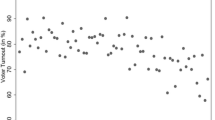Abstract
This article offers a macro-level approach to a core concept in the study of electroral behavior, the normal vote. The approach uses interrupted time-series analysis and focuses upon electorally homogeneous political regions within states. After developing the approach used to generate normal vote estimates, analyses using those estimates are compared with (1) parallel analyses using survey-based research, and (2) across levels of analysis (national, regional). The comparison with survey-based analyses show that the macro-level measure follows the actual vote more closely and is more sensitive to shortterm influences. Comparisons across levels of analysis demonstrate that national level analyses obscure a volatile, dynamic electorate that exists at the regional level. These findings suggest that the creative use of the macro-level measure at the regional level has the potential to contribute new and important insights into the role of citizens in American politics, and the forces that drive the behavior of the electorate. Its particular strengths lie in the study of electoral change and its ability to contribute toward a developmental perspective on American democracy.
Similar content being viewed by others
References
Abramson, Paul R., and Charles W. Ostrom Jr. (1992). Response.American Political Science Review 86: 481–486.
Abramson, Paul R. and Charles W. Ostrom Jr. (1991). Macropartisanship: An empirical reassessment.
Aldenderfer, Mark S., and Roger K. Blashfield (1984).Cluster Analysis. Beverly Hills: Sage.
Box, G. E. P., and G. C. Tiao (1975). Intervention analysis with applications to economic and environmental problems.Journal of the American Statistical Association 70: 70–79.
Burnham, Walter Dean (1970).Critical Elections and the Mainsprings of American Politics. New York: Norton.
Burnham, Walter Dean (1991). Critical realignment: Dead or alive. In Byron, Schafer (ed.),The End of Realignment? Madison: University of Wisconsin Press.
Campbell, Angus, Philip E. Converse, Warren E. Miller, and Donald E. Stokes (1960).The American Voter New York: Wiley.
Carmines, Edward, and James A. Stimson (1989).Issue Evolution: Race and the Transformation of American Politics. Princeton, NJ: Princeton University Press.
Clubb, Jerome M., William H. Flanigan, and Nancy H. Zingale (1980).Partisan Realignment: Voters Parties, and Government in American History. Beverly Hills: Sage.
Converse, Philip E. (1966). The concept of a normal vote. In Angus Campbell, Philip E. Converse, Warren Miller, and Donald Stokes (eds),Elections and the Political Order. New York: John Wiley and Son.
Elazar, Daniel J. (1970),Cities of the Prairie. New York: Basic Books.
Fenton, John H. (1957),Politics in the Border States. New Orleans: Hauser Press.
Fenton, John H. (1966).Midwest Politics. New York: Holt, Rinehart and Winston.
Fiorina, Morris P. (1981).Retrospective Voting in American National Elections. New Haven, CT: Yale University Press.
Fiorina, Morris P. (1990). The electorate in the voting booth. In L. Sandy Maisal (ed.),The Parties Respond: Changes in the American Party System. Boulder, CO: Westview Press.
Gottman, John (1984).Time-Series Analysis for Social Scientists. Cambridge: Cambridge University Press.
Huckfeldt, Robert, and John Sprague (1993). Citizens, contexts, and politics. In Ada Finifter (ed.),Political Science: The State of The Discipline (2nd Ed.). Washington, D.C.: APSA.
Key, V. O. (1949).Southern Politics in State and Nation. New York: Random House.
Key, V. O. (1955). A theory of critical elections.Journal of Politics 17: 3–18.
Kleppner, Paul (ed.) (1981).The Evolution of American Electoral Systems. Westport, CT: Greenwood Press.
Leighley, Jan E. and Jonathan Nagler (1992). Socioeconomic bias in turnout 1964–1988: The voters remain the same.American Political Science Review 86: 725–736.
Lockard, Duane (1959).New England State Politics. Chicago: Henry Regnery.
Lorr, Maurice (1987).Cluster Analysis for Social Scientists., San Francisco: Josey Bass.
MacKuen, Michael B., Robert S. Erickson, and James A. Stimson (1989). Macropartisanship.American Political Science Review 83: 1125–1142.
MacKuen, Michael B., Robert S. Erickson, and James A. Stimson, (1992). Question wording and macropartisanship.American Political Science Review 86: 475–481.
MacKuen, Michael B., Robert S. Erickson, and James A. Stimson (1992a). Peasants or bankers? The American electorate and the U.S. economy.American Political Science Review 86: 597–611.
McCleary, Richard, and Richard A. Hay, Jr. (1980).Applied Time Series Analysis for the Social Sciences. Beverly Hills: Sage.
McDowall, David, Richard McCleary, Erroll E. Meidinger, and Richard A. Hay, Jr. (1980).Interrupted Time Series Analysis. Beverly Hills: Sage.
Miller, Warren (1991). Party identification, realignment, and party voting: Back to basics,American Political Science Review 85: 557–570.
Nardulli, Peter F. (1989). Geo-political cleavages, conflict and the American states. InDiversity, Conflict, and State Politics, Urbana, IL: University of Illinois Press.
Nardulli, Peter F. (1995). The concept of a critical realignment, electoral behavior, and political change.American Political Science Review (forthcoming).
Petrocik, John R. (1989). An expected party vote: New data for an old concept.American Journal of Political Science 33: 44–66.
Shafer, Byron E. (1991).The End of Realignment? Interpreting American Electoral Eras. Madison, WI: University of Wisconsin Press.
Shafer, Byron E. (1991a). The notion of an electoral order. In Byron Shafer (ed.),The End of Realignment? Interpreting American Electoral Orders. Madison, WI: University of Wisconsin Press.
Shively, W. Phillips (1992). From differential abstention to conversion: A change in electoral change, 1864–1988.American Journal of Political Science 36: 309–330.
Silbey, Joel H. (1991).The American Political Nation, 1838–1893. Stanford: Stanford University Press.
Sundquist, James L. (1973).Dynamics of the Party System: Alignment and Realignment of Political Parties in the United States. Washington, D.C.: The Brookings Institution.
Wattenberg, Martin P. (1990).The Decline of American Political Parties, 1952–1988. Cambridge: Harvard University Press.
Author information
Authors and Affiliations
Rights and permissions
About this article
Cite this article
Nardulli, P.F. A normal vote approach to electoral change: Presidential elections, 1828–1984. Polit Behav 16, 467–503 (1994). https://doi.org/10.1007/BF01498827
Issue Date:
DOI: https://doi.org/10.1007/BF01498827




